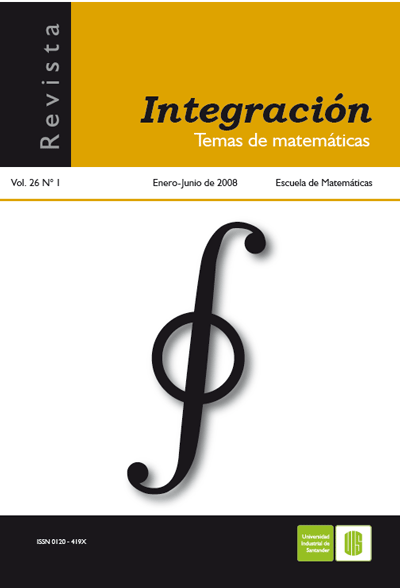A Model of the Molecular Aggregate Processes of Hemoglobin S. Absence of Cristallization
Publicado 2008-02-29
Palabras clave
- Polymerization,
- Hemoglobin S,
- Sickle Cell, Modeling
Cómo citar
Resumen
Los mecanismos de formación molecular agregada desempeña un papel importante en la interpretación de la patofisiología de la anemia de células falciformes (o anemia drepanocítica), y en la selección de las estrategias terapéuticas a seguir.
Aquí se propone un mecanismo y un modelo matemático. el modelo postula la existencia de microtúbulos defectivos formados por deoxihemoglobina S y oxihemoglobina S, y explica la dependencia de la polimerización de la concentración de hemoglobina, la temperatura y la presión parcial de oxígeno. El análisis hace énfasis en la polimerización de hemoglobina S en la ausencia de cristalización. La acción de otras clases de hemoglobinas en la formación molecular agregada puede ser explicada.
Descargas
Referencias
[2] W.A. Eaton, J. Hofrichther, “Sickle Cell Hemoglobin Polymerization”, Advances in Protein Chemistry. 40 (1990) 63-279.
[3] C.T. Noguchi, A.N. Schechter, “The Intracellular Polymerization of Sickle Hemoglobin and its Relevance to Sickle Cell Disease”, Blood. 58 (1981) 1057-1068.
[4] G.M. Brittenham, A.N. Schechter, C.T. Noguchi, “Hemoglobin S Polymerization: Primary Determinant of the Hemolytic and Clinical Severity of the Sickling Syndromes”, Blood. 65 (1985) 183-189.
[5] J. Dean, A.N. Schechter, “Sickle-cell anemia. Molecular and cellular bases of therapeutic approaches”, N. Engl. J. Med. 299 (1978) 725-763.
[6] R.W. Brieehl, “Gelation of Sickle Cell Hemoglobin. IV. Phase Transition in Hemoglobin S Gels: Separate Measures of Aggregation and Solution-Gel Equilibrium”, J. Mol. Biol. 123 (1978) 521-538.
[7] J. Han, J. Herzfeld, “Interpretation of the Osmotic Behavior of Sickle Cell Hemoglobin Solutions: Different Interactions Among Monomers and Polymers”, Biopolymer. 45 (1998) 299-306.
[8] H. Chang, R.L. Nagel, “Measurement of Sickling by Controlled Temperature Increase”, Blood. 52 (1978) 1189-1195.
[9] R.C. Cheetham, E.R. Huehns, M.A. Rosemeyer, “Participation of Hemoglobins A, F, A2 and C in Polymerization of Hemoglobin S”, J. Mol. Biol. 129 (1979) 45-61.
[10] R.E. Benesch, R. Benesch, R. Edalji, S. Kwong, “Intramolecular Effects in the Polymerization of Hemoglobin S”, Biochem. Biophys. Res. Comm. 81 (1978) 1307-1312.
[11] H.R. Sunshine, J. Hofrichter, W.A. Eaton, “Gelation of Sickle Cell Hemoglobin in Mixtures with Normal Adult and Fetal Hemoglobins”, J. Mol. Biol. 133 (1979) 435-467.
[12] A.N. Schechter, G.P. Rodgers, “Sickle Cell Anemia, basic research in the clinic”, N. Eng. J. Med. 332 (1995) 1372-1374.
[13] H.F. Bunn, “Pathogenesis and Treatment of Sickle Cell Disease”, N. Engl. J. Med. 337 (1997) 762-769.
[14] K. Bailey, J.S. Morris, P. Thomas, G.R. Serjeant, “Fetal hemoglobin and earlymanifestation of homozygous sickle cell disease”, Arch. Disea. Childhood. 67 (1992) 517-520.
[15] T.E. Wellems, R. Josephs, “Crystallization of Deoxyhemoglobin S by Fiber Alignment and Fusion”, J. Mol. Biol. 135(1979) 651-674.
[16] X.Q. Mu, B. Fairchild, “Computer models of a new deoxy-sickle cell hemoglobin fiber based on x-ray diffraction data”, Biophys. J. 61(1992) 1638-1646.
[17] T.H. Maugh, “A New Understanding of Sickle Cell Emerges. X-ray, kinetic studies paint a comprehensive picture of Sickle Cell Disease to the level of atomic interactions”, Science.211 (1981) 265-267.
[18] A.N. Schechter, C.T. Noguchi, “Sickle Hemoglobin Polymer: Structure-Function Correlates”, Chap. 4. In Sickle Cell Disease: Basic Principles and Clinical Practice. Ed. by S.H. Embury, R.P. Hebbel, N. Mohandas, M.H. Steinberg, Raven Press, Ltd, New York, 1994.
[19] A.A. Kaperonis, D.A. Handley, S. Chien, “Fibers, Crystals, and other Forms of HbS Polymers in Deoxygenated Sickle Erythrocytes”, Am. J. Hematol. 21 (1986) 269-275.
[20] G.W. Dykes, R.H. Crespeau, S. J. Edelstein, “Three–dimensional reconstruction of 14-filament fibers of hemoglobin”, J. Mol. Biol. 130 (1979) 451-472.
[21] A. Roufberg, F.A. Ferrone, “A model for the sickle hemoglobin fiber using both mutation sites”, Protein Sci. 9 (2000) 1031-1034.
[22] A. McPherson, “Current approaches to macromolecular crystallization”, Eur. J. Biochem. 189 (1990) 1-23.
[23] G. Agarwal, J.C. Wang, S. Kwong , S.M. Cohen, F.A. Ferrone, R. Josephs, R.W. Briehl, “Sickle hemoglobin Fibers: Mechanisms of Depolymerization”, J. Mol. Biol.322 (2002) 395-412.
[24] P.C. Weber, “Protein Crystallization”, Advan. in Protein Chemistry. 41 (1991) 1-5.
[25] F.A. Ferrone, J. Hofrichter, W.A. Eaton, “Kinetics of sickle hemoglobin polymerization I. Studies using temperature jump and laser photolysis techniques”, J. Mol. Biol.183 (1985) 591-610.
[26] F.A. Ferrone, J. Hofrichter, and W.A. Eaton, “Kinetics of Sickle Hemoglobin Polymerization. II A double nucleation mechanism”, J. Mol. Biol. 183 (1985) 611-631.
[27] M. Ivanova, R. Jasuja, S. Kwong, R.W. Briehl, F.A. Ferrone, “Nonideality and the nucleation of sickle hemoglobin”, Biophys. J. 79 (2000) 1016-1022.
[28] V.B Makhijani., G.R. Coketet, A. Clark, “Dymanics of oxygen unloading from sickle erythrocytes”, Biophys. J. 58 (1990) 1025-1050.
[29] F.A. Ferrone, M. Ivanova, R. Jasuja, “Heterogeneous Nucleation Crowding in Sickle Hemoglobin. An Analytic Approach”, Biophys. J. 82 (2002) 399-406.
[30] M. Ivanova, R. Jasuja, S. Kwong, R.W Briehl, F.A. Ferrone, “Nonideality and the nucleation of Sickle Hemoglobin”, Biophys. J. 79 (2000) 1012- 1022.
[31] C. Cabal, A. Fernández, M. Lores, E. Álvarez, J. Losada, C. Soler, E. Pérez, “Magnetic Relaxation in the Kinetics of the Polymerization of Hemoglobin S. Clinical Diagnosis and Treatment with Vanillin”, Proceedings International Society for MagneticResonance in Medicine, 3 (1998) 1705, Sydney, April 18-24.
